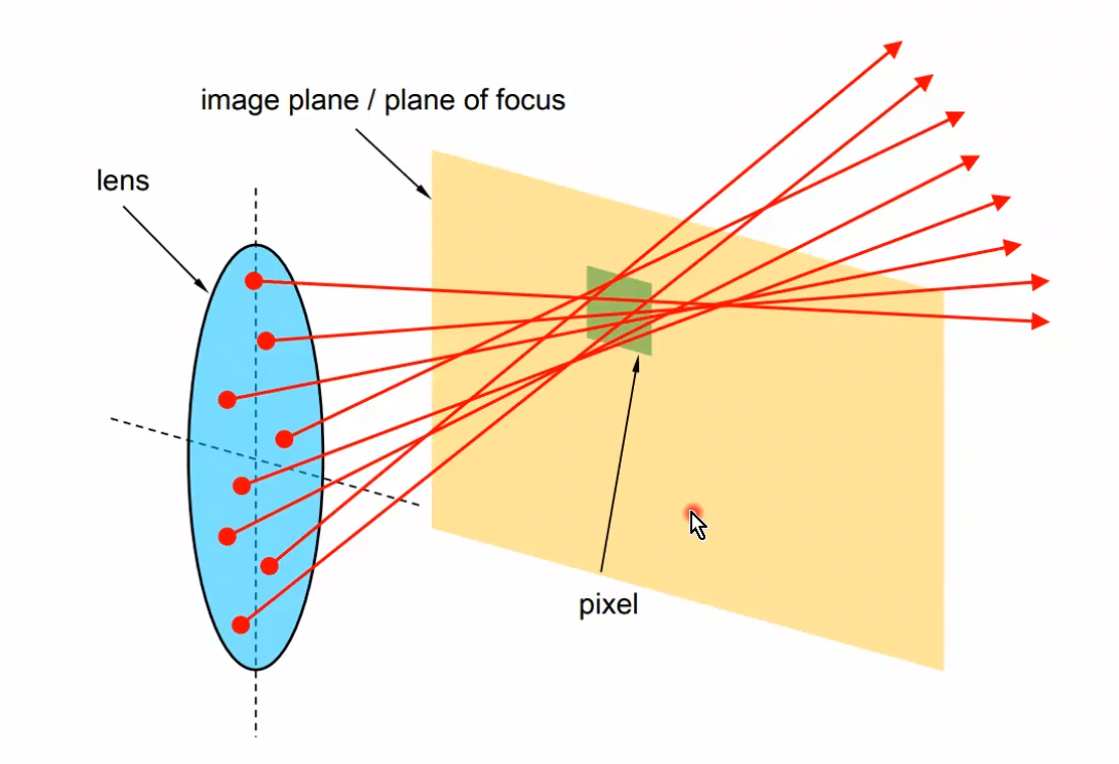
Most info can be found at CS3241 Chapter 9.
Whitted ray tracing:
\[I = I_\text{local} + k_{rg}I_\text{reflection} + k_{tg}I_\text{transmitted}\]Lighting computation:
\[I_\text{local} = I_ak_a + k_\text{shadow}I_\text{source}[k_d(N \cdot L) + k_r(R \cdot V)^n + k_t(T \cdot V)^m]\]Scene description in raytracing:
gluLookAtgluPerspective but no near/far planePsuedocode:
render() {
for each pixel:
ray = eye to pixel
pixelColor = trace(ray)
}
trace(ray) {
hit = (t = inf, hitPos = null, hitNormal = null, hitMaterial = null)
for each object in scene:
if intersect(object, ray) is nearer, set as hit
color = shade(ray, hit.hitPos, hit.hitNormal, hit.hitMaterial);
}
shade(ray, point, normal, material) {
for each light source:
trace a shadow ray to light source
if intersect(light source, shadow ray):
color += lighting(point, normal)
if specular:
color += trace(reflect(ray))
if translucent:
color += trace(refract(ray, material.refractiveIndexRatio))
}
## Ray Tracing Acceleration Research mostly within
Not very effective. Modifies the allowed recursion depth based on pixel.
Also not very effective. Uses item buffer to identify first-hit object at each pixel.
Replaces complex object ray-intersection computation with simple object ray-intersection cocmputation. Ray-intersection with each object’s bounding volume; when no intersection, discard this object altogether.
Examples of bounding volumes:
First compute intersection with root bounding box ($a$). Then compute for the next bounding box containing that object (e.g. $c$). Then compute for the next bounding box containing that object (e.g. $c_3$). Keep computing until discard or lighting computation.
Usually good hierarchies are constructed manually.
Subdivision of 3D space into regions Each regions has a list of objects in it. When ray traced into region, query the object list and perform intersection tests on those objects. Since we are looking for the nearest intersection, the ray should be traced from a front-to-back order through the regions.
Conditional schemes:

| Whitted | Distribution |
|---|---|
| hard shadows | area lights, soft shadows |
| blur specular highlight (phong computation), with sharp reflections | blurred reflections and refractions both |
| aliasing | anti-aliasing |
| no caustics (focusing of light on surface) | NO caustics |
| no color bleeding of diffuse surfaces | NO color bleeding |
Distribution ray tracing also demonstrates depth of field and motion blur.
Perturbing reflection ray also allows us to have glossy reflection.

Per pixel: shoot out random multiple primary rays, whose fetched colors are averaged. Per intersection: reflection, refraction, shadow rays are randomly perturbed.
Psuedocode:
render() {
for each pixel:
for each sample:
ray = randomOffset(eye lens) to randomOffset(pixel)
pixelColor = trace(ray)
pixelColor /= samples
}
trace(ray) {
hit = (t = inf, hitPos = null, hitNormal = null, hitMaterial = null)
for each object in scene:
if intersect(object, ray) is nearer, set as hit
color = shade(ray, hit.hitPos, hit.hitNormal, hit.hitMaterial);
}
shade(ray, point, normal, material) {
for each light source:
trace a randomPerturbed(shadow ray) to Area light source
if intersect(light source, shadow ray):
color += lighting(point, normal)
if specular:
color += trace(randomPerturbed(reflect(ray)))
if translucent:
color += trace(randomPerturbed(refract(ray, material.refractiveIndexRatio)))
}